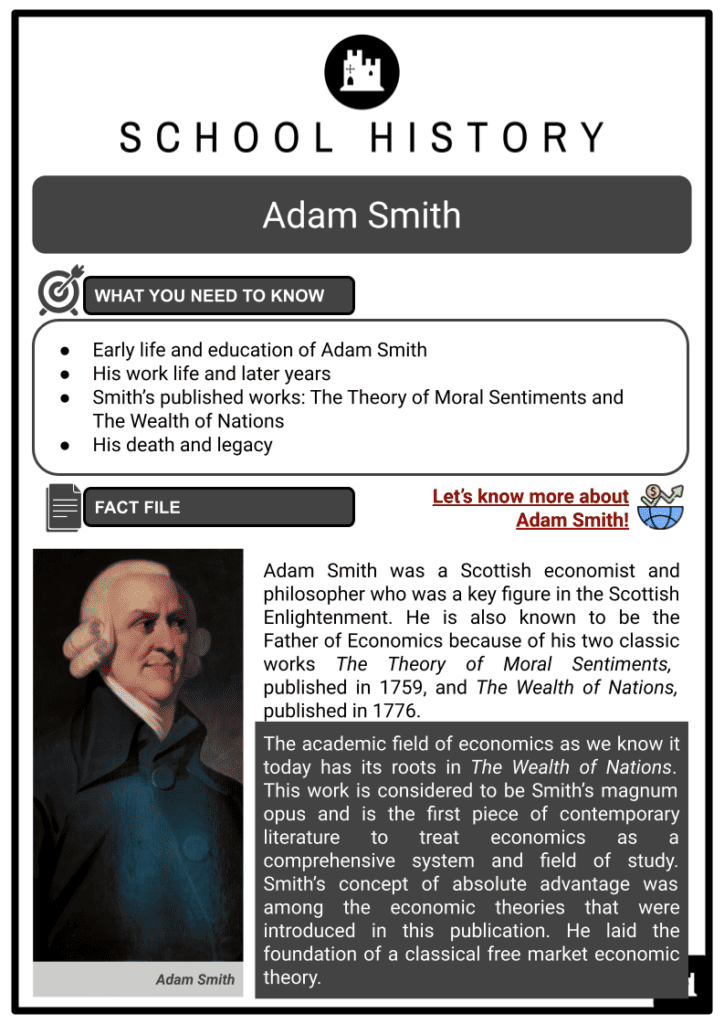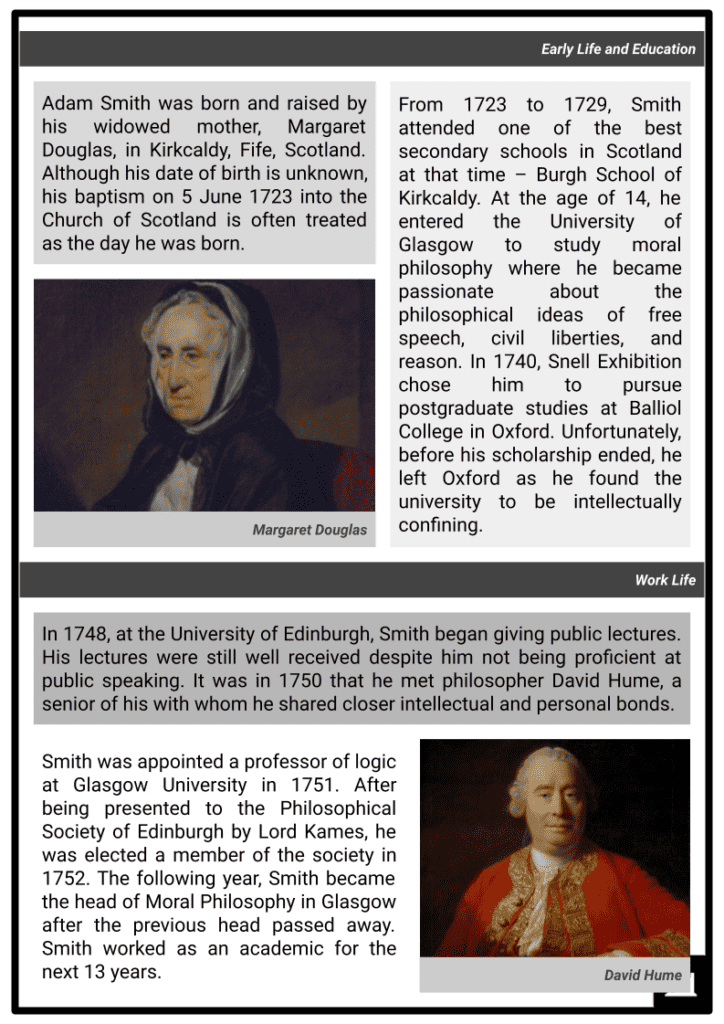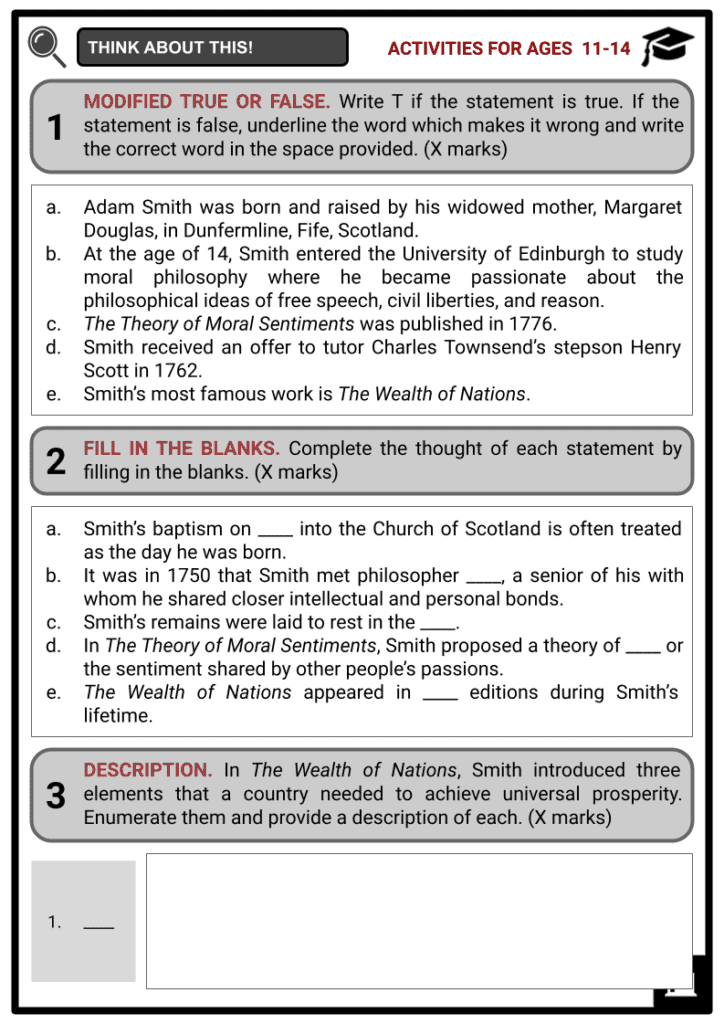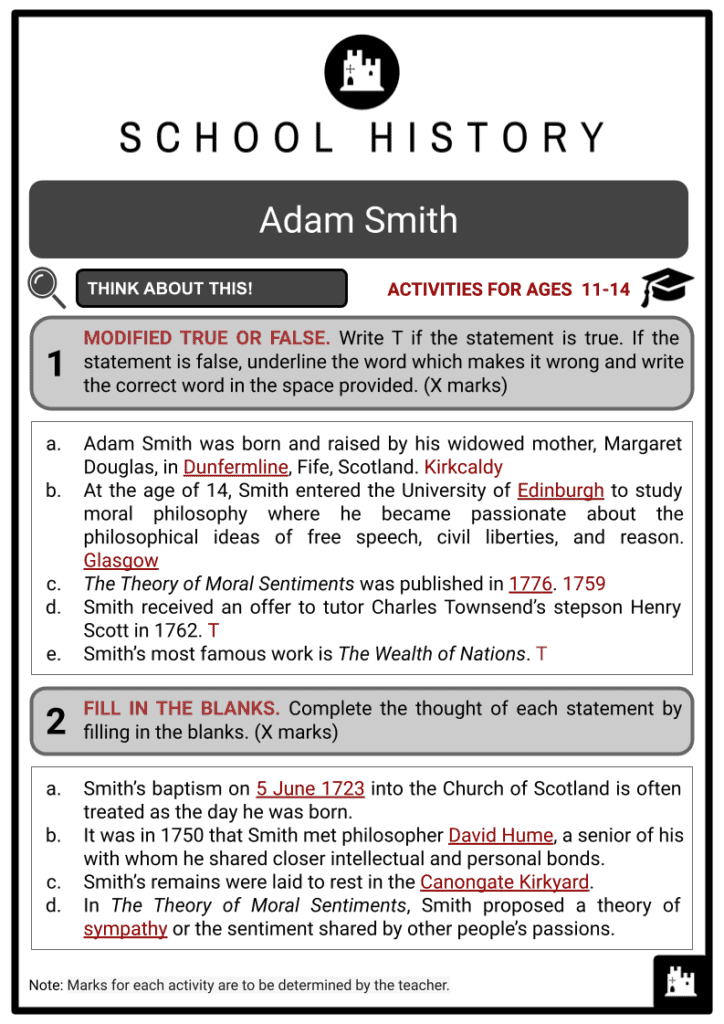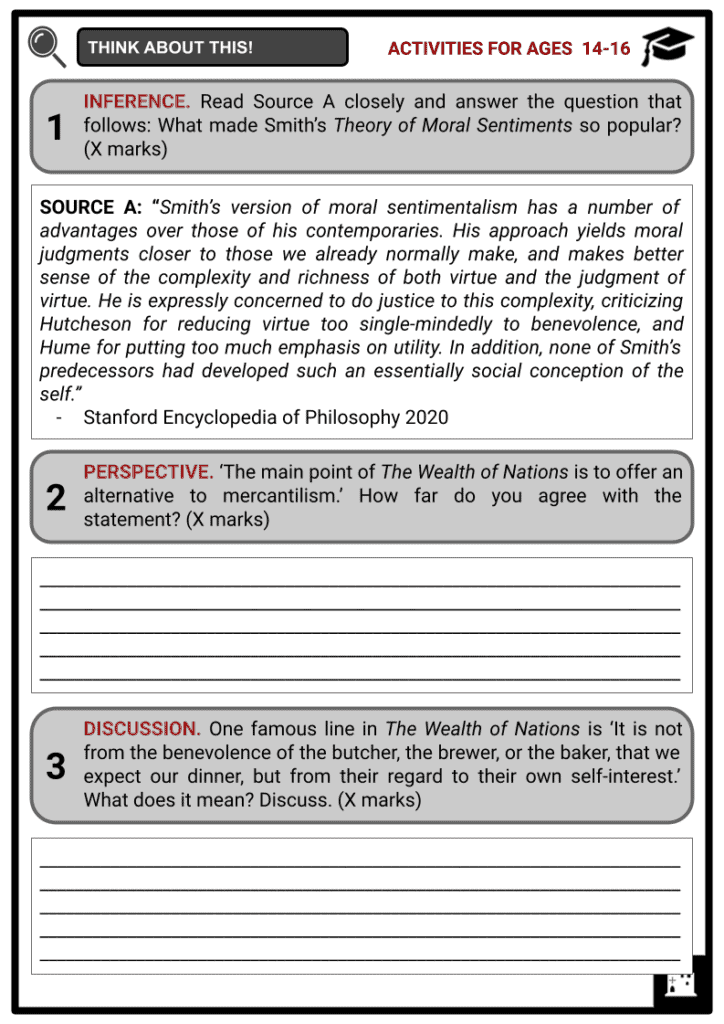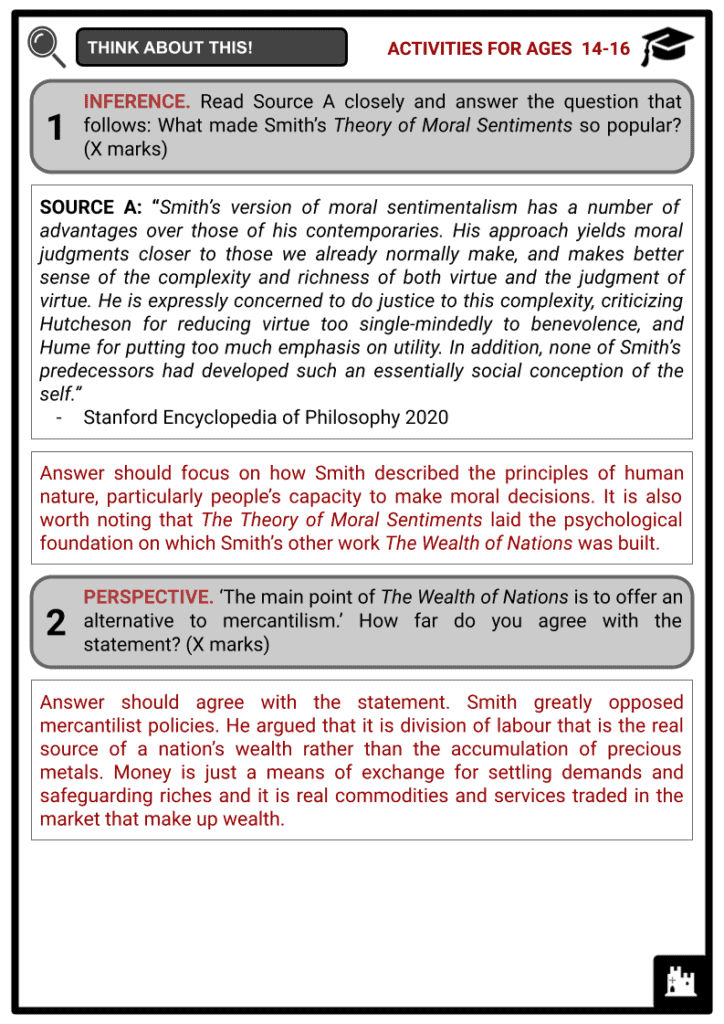Adam Smith Worksheets
Do you want to save dozens of hours in time? Get your evenings and weekends back? Be able to teach about Adam Smith to your students?
Our worksheet bundle includes a fact file and printable worksheets and student activities. Perfect for both the classroom and homeschooling!
Summary
- Early life and education of Adam Smith
- His work life and later years
- Smith’s published works: The Theory of Moral Sentiments and The Wealth of Nations
- His death and legacy
Key Facts And Information
Let’s know more about Adam Smith!
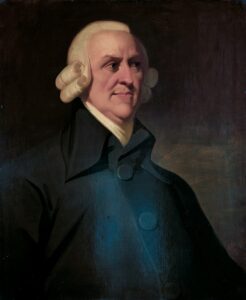
Adam Smith was a Scottish economist and philosopher who was a key figure in the Scottish Enlightenment. He is also known to be the Father of Economics because of his two classic works The Theory of Moral Sentiments, published in 1759, and The Wealth of Nations, published in 1776. The academic field of economics as we know it today has its roots in The Wealth of Nations. This work is considered to be Smith’s magnum opus and is the first piece of contemporary literature to treat economics as a comprehensive system and field of study. Smith’s concept of absolute advantage was among the economic theories that were introduced in this publication. He laid the foundation of a classical free market economic theory.
Early Life and Education
- Adam Smith was born and raised by his widowed mother, Margaret Douglas, in Kirkcaldy, Fife, Scotland. Although his date of birth is unknown, his baptism on 5 June 1723 into the Church of Scotland is often treated as the day he was born.
- From 1723 to 1729, Smith attended one of the best secondary schools in Scotland at that time – Burgh School of Kirkcaldy. At the age of 14, he entered the University of Glasgow to study moral philosophy where he became passionate about the philosophical ideas of free speech, civil liberties, and reason. In 1740, Snell Exhibition chose him to pursue postgraduate studies at Balliol College in Oxford. Unfortunately, before his scholarship ended, he left Oxford as he found the university to be intellectually confining.
Work Life
- In 1748, at the University of Edinburgh, Smith began giving public lectures. His lectures were still well received despite him not being proficient at public speaking. It was in 1750 that he met philosopher David Hume, a senior of his with whom he shared closer intellectual and personal bonds.
- Smith was appointed a professor of logic at Glasgow University in 1751. After being presented to the Philosophical Society of Edinburgh by Lord Kames, he was elected a member of the society in 1752. The following year, Smith became the head of Moral Philosophy in Glasgow after the previous head passed away. Smith worked as an academic for the next 13 years.
- It was in 1759 that he published his first book The Theory of Moral Sentiments. Following the release, his popularity grew and many wealthy students went to Glasgow to study under him. At this point, Smith started to focus less on his theories of morality and more on law and economics in his lectures. In 1762, the University of Glasgow awarded him the title of Doctor of Laws (LLD). When Smith received an offer to tutor Charles Townsend’s stepson Henry Scott in 1762, he resigned from his position as professor.
- His tutoring profession earned him £300 per year, plus expenses, and another £300 per year in pension. This was double what he had been earning as a teacher. While tutoring Henry on a range of topics, Scott also travelled with him all over Europe.
- It was during his travels that he met Voltaire, Benjamin Franklin, d’Alembert, Rousseau, Helvétius, Quesnay, Turgot and Morellet. Smith’s travels aided in the creation of his most famous work The Wealth of Nations, which was published in 1776.
- Smith’s growing notoriety helped him get a position as Scotland’s commissioner of customs. It was here that he assisted the government in enforcing anti-smuggling laws. His last 10 years were consumed by his position in government.
Later Years
- When Smith’s tutoring ended after Henry Scott’s younger brother passed away in Paris in 1766, Smith returned to Kirkcaldy and spent the next 10 years writing The Wealth of Nations. In May 1773, he was elected a fellow of the Royal Society of London and later became a member of the Literary Club in 1775.
- Smith moved to Panmure House in Edinburgh’s Canongate with his mother in 1778 when he was appointed as commissioner of customs in Scotland. His mother would pass away six years later.
- In 1783, Smith became one of the founding members of the Royal Society of Edinburgh. From 1787 to 1789, he held the honorary position of Lord Rector of the University of Glasgow.
Published Works
- Smith is regarded as ‘The Father of Economics’ for his contribution to the field through his classic works, The Theory of Moral Sentiments and The Wealth of Nations.
- Smith’s first work, The Theory of Moral Sentiments, was published in 1759. The work explored the nature of morality and human behaviour. Up until his passing, he made significant revisions to the work.
- Given that people begin life with no moral sentiments, Smith’s aim in writing the work was to explain the source of humankind’s ability to form moral judgement. According to him, conscience arises from interactive social relationships through which people seek ‘mutual sympathy of sentiments’.
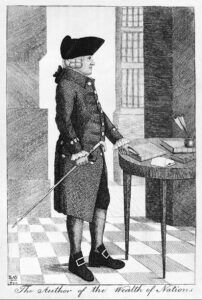
A portrait of Adam Smith - He therefore proposed a theory of sympathy or the sentiment shared by other people’s passions. It operated on the principle of mirroring or the process of echoing what we observe in others. By reacting to one another and imagining how we would react in the other person’s situation, we establish our moral sense of appropriate behaviour and our understanding of the difference between right and wrong.
- Smith explains the concept more by discussing the projection of emotions towards neutral objects or situations. He uses the pointlessness of mourning as an example. According to him, it is useless to be sad for the dead because they have no feelings. Instead, we are just feeling sad ourselves and assuming that the dead feel the same.
- Smith’s most important work and magnum opus is An Inquiry into the Nature and Causes of the Wealth of Nations or simply The Wealth of Nations, where many concepts that are the foundation of classical economics were popularised.
- For one, the classical economic theory that dominated the field of economic thought throughout the Great Depression, was strengthened by economists who took inspiration from the work of Smith, such as Milton Friedman, David Ricardo, John Maynard Keynes and Karl Marx.
- The book was published in two volumes on 9 March 1776 and was able to influence a lot of economists, authors, organisations and governments at that time. It took Smith 10 years to produce it but it was worth it as the end product attempted to provide a practical application for updated economic theory to take the place of outdated doctrines in the era of the Industrial Revolution.
- Although The Wealth of Nations appeared in five editions during Smith’s lifetime (1776, 1778, 1784, 1786 and 1789), countless editions followed his passing in 1790. The first five volumes were compiled by a group under Edwin Cannan’s direction. While the first and second editions have minor but numerous differences, the differences between the second and the third are major. The fourth and fifth editions only had trivial differences.
- The primary thesis of The Wealth of Nations revolves around Smith’s argument that allowing free trade (freedom to create and trade goods as much as you like), and opening the markets to domestic and foreign competition, will encourage greater prosperity more than what strict government rules could offer.
- Smith called this free-market force the invisible hand. He argues that this hand needed support, creating a series of mutual interdependencies. He thought that people were frequently selfish mostly when it comes to economic problems and concluded that self-seeking individuals were led by this invisible hand that unintentionally acts in ways that yet help society. In simple terms, Adam Hayes (2022) explained:
“If you specialise as a baker and produce only bread, you must rely on somebody else for your clothes, your meat, and your beer. Meanwhile, the people that specialise in clothes must rely on you for their bread, and so on. Prosperity emanates from the market that develops when people need goods and services that they can't create themselves.”
- Smith believed that a country needed three elements to achieve universal prosperity: enlightened self-interest, limited government, and a solid currency and free-market economy.
Enlightened Self-Interest
- Smith thought that most people practise enlightened self-interest naturally. He used the work of a butcher as an example. According to him, a butcher does not supply meat out of good-hearted intentions, but rather because the butcher makes money from the sale of meat. The butcher won’t make any money if the meat offered is of poor quality.
- So that both sides profit in every transaction, it is in the butcher’s best interest to sell good meat at a price that customers are willing to pay. Smith thought that most organisations would refrain from mistreating customers if they had a long-term perspective. He looked to the government to enforce the law when that wasn’t sufficient.
- Smith also valued savings, particularly when they were invested. Investments would provide businesses with funds necessary to purchase labour-saving equipment and this technological advancement would boost returns on investment and raise the standard of living.
Limited Government
- Smith saw that the responsibilities of the government were limited to universal education, defence of the nation, justice system, and infrastructure. He argued that any government intervention outside of these has a detrimental effect on economic expansion.
- The purpose of universal education is to combat the detrimental and depressing effects of the division of labour, which is an essential component of industrialisation.
Solid Currency and Free-Market Economy
- By circulating more money, Smith sought to limit the government’s capacity to devalue it. This might then reduce needless spending, such as on wars.
- Smith favoured a free-market system of government. This included lowering taxes and eliminating tariffs to enable unrestricted cross-border trade. He emphasised that tariffs and other taxes only increase the cost of living while strangling trade and industry overseas.
Death
- On 17 July 1790, Smith died in Panmure House in Edinburgh after a painful illness. His remains were laid to rest in the Canongate Kirkyard. On his deathbed, Smith expressed regret that he had not accomplished more.
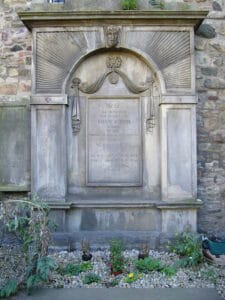
Smith's burial place - Joseph Black and James Hutton served as Smith’s literary executors. The latter left behind some notes and unpublished works but instructed Black and Hutton to remove everything that was unfit for publishing. He did, however, suggest an early unpublished History of Astronomy. In 1795, it appeared along with other materials such as Essays on Philosophical Subjects.
- Since he never married or had children of his own, his heir was his closest relative, David Douglas, Lord Reston. According to his will, Smith left his library to David. It was later split between David’s two surviving children, David Anne and Cecilia Margaret.
- Little is actually known about the personal life of Smith. This might be because it was customary at that time to destroy private files of distinguished men. Only one portrait of him survived and many of his unfinished works were destroyed.
Image Sources
- https://upload.wikimedia.org/wikipedia/commons/thumb/4/43/Adam_Smith_The_Muir_portrait.jpg/800px-Adam_Smith_The_Muir_portrait.jpg
- https://upload.wikimedia.org/wikipedia/commons/thumb/2/25/AdamSmith1790b.jpg/800px-AdamSmith1790b.jpg
- https://upload.wikimedia.org/wikipedia/commons/thumb/f/fc/Adam_Smith_Grave.JPG/800px-Adam_Smith_Grave.JPG

